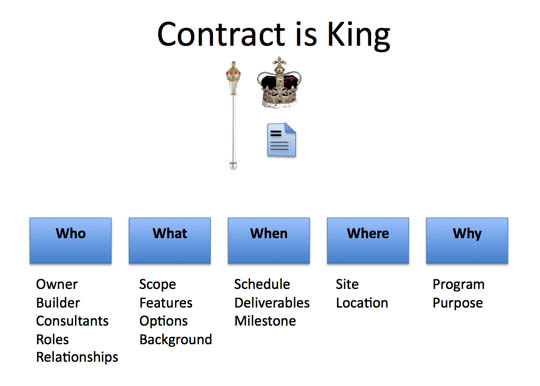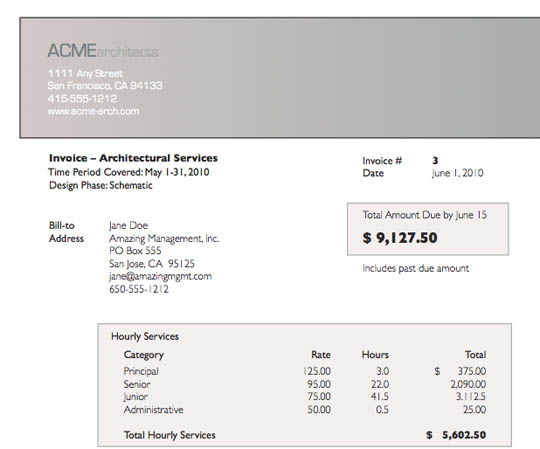
Billing and Client Communication
by Rebecca Firestone with Mark English AIA | Other Voices
“We need to increase our value with our clients as service providers, and part of providing good service is to show a clear-headed understanding of money,” advises Michael Bernard. “Use the contract to convey established billing practice,” advises Bernard. “The contract is the memory of the project, with all parties signatory.”
What should be shown on the invoice? “Sometimes the owner gives us an invoice template,” says Bernard. “I attach this invoice to the sub-consultant agreement so that the sub-consultants can see how the information they provide to me is in turn provided to the client.”
[ This article was written in conjunction with Michael Bernard, our “Ask Michael” columnist, and addresses billing from the standpoint of smaller firms with a focus on custom single-family residential work for private owners. ]
Invoicing and collecting payment are a key element in the designer-client relationship, one which is often overlooked particularly with small firms serving private residential clients. A designer may feel embarrassed to be demanding specific sums of money from his clients. Or she may feel that the relationship that she has with her clients is so personal, so delicate, that even a single invoice would drive them all away. Some designers may try to hold off on invoicing until the client is too emotionally invested in the project to back out. Then they send a huge invoice, and the fight happens anyway, only it’s worse than ever.
Needless to say, these self-deluding habits don’t serve anyone – not you, and not your clients, either. If you don’t know how to ask for money for your services in a way that gets you paid, the consequences are obvious.
Billing should be treated as one of the fundamental business practices of small and large firms alike, rather than an afterthought. Yes, the design work is important because after all, that’s why your clients are coming to you. In terms of cash flow, collecting is one of the biggest challenges especially for small firms – and yet, the AIA Handbook has very little advice to offer on things like what information an invoice should contain, how it should be presented, or what to do if payments are not received in a timely fashion.
Is Billing The Real Problem?
When most of us think of collections, we think of third-party agents calling up deadbeats and threatening them with increasingly scary penalties. That attitude doesn’t go over well with a private design client, even if that client owes tens of thousands of dollars in fees. Some architects end up in a downward spiral of gamesmanship with their clients, each of them trying to hold the other over a barrel – with the bill as the focus of contention. But is that the real problem?
Typically, both client and architect argue about fees when other problems arise. Could it be that we’re fixing the wrong problem here? They say an ounce of prevention is worth a pound of cure. How can we line up all our ducks in a row so that misunderstandings never even have a chance to develop?

For many professionals, client disputes stem from a lack of trust - which in turn arises when the parties have failed to establish shared understandings and common goals from the onset. And, sadly, some people derive more satisfaction from "winning" than from actually accomplishing anything. Art: "The Conjuror" by Hieronymous Bosch shows a crowd fascinated by a street magician. The magician's accomplice steals their purses while they're distracted
That’s essentially the strategy outlined by Michael Bernard, AIA who is not only an architect himself, but also a seasoned management professional specializing in business consulting for design firms. Through his own firm, Virtual Practice, Mr. Bernard works with over 50 clients consisting of firms both small and large, ranging from sole proprietorships to firms of over 30 people with offices in Northern and Southern California cities. I figured if anyone would know the answer to this question, it’d be be him.
Culture of Billing
“You have to create a culture of billing,” says Bernard. “You need to create a structure which will allow you to collect fees. You don’t have to be shy about it. It’s what keeps your business moving forward.”
“Be rigorous in billing every month.” Bernard was emphatic. “Some firms delay up to three months, but they’re losing money by doing that.” It really takes commitment from the principals, not just hiring a bookkeeper and putting the problem in someone else’s hands.
This culture should extend to all of your employees as well. “A typical office might issue something like 20-50 invoices a month. Your staff needs to understand how the work they do supports the well-being of the firm. Part of this is to understand that completing their timesheets accurately and on time is what helps the office to get paid on time.”
The Contract is King
As it turns out, fee disputes are often the first symptom of weaknesses in the architect-client relationship that had gone undetected, and one of the biggest weaknesses is not clarifying relationships and expectations at the very beginning. The early stages of engagement are a delicate time and many architects tread lightly to avoid frightening off a potential client. After all, if the clients are that leery of spelling out commitments on paper, do you REALLY want to work with them?
“Use the contract to convey established billing practice,” advises Bernard. “The contract is the memory of the project, with all parties signatory.” The contract spells out who the parties are, their roles and responsibilities vis a vis one another, the scope of the work to be performed, a proposed timetable, a fee structure, and billing practice as well.

With a good contract, all the other "courtiers" must submit equally to the royal sceptre. These are the who, the what (scope and cost), the when, the where, and the why (program).
“California law stipulates that architects may not perform design or construction services without a signed agreement with the client,” Bernard reminded me. Sometimes a firm will commence work to meet a demanding schedule and simultaneously try to work out the contracting details. This is almost always a risky practice, not only because it’s illegal but because it just postpones little issues until they become big ones. Even in cases where there’s not a moment to lose, get an agreement in place and then work out the contract as quickly as possible. An initial agreement can be as simple as a letter of understanding.
Although Bernard didn’t provide a timetable for finalizing a contract, I’m going to go out on a limb and say that letters of agreement should only hold for the first billing cycle, and if the client can’t agree to a contract after that time, the architect is inviting trouble by letting it slide.
Consider Client Response Times
One issue that I have seen as problematic on other projects are clients who are simultaneously demanding but who are also unavailable half the time for important decisions, or who are so preoccupied with their other affairs that they don’t have the bandwidth to think about things like finalizing and signing their contract agreements. If your clients are overseas for long periods of time, for example, you should get another designated responsible party who is empowered to act on the owners’ behalf, and clearly convey to the client the costs and consequences of project delays. “A simple solution is to include in the agreement the name of the designated project representative. This can be the owner or another party,”advises Bernard.
Even so, there are some decisions that can really only be made by the owner, and if the owners can’t understand the implications of delays, then the architect may have to expend considerable effort to keep the project on track.
Use Examples in the Contract to Illustrate and Convey Expectations
The contract can be used to set expectations by example as well as by description. “If you have third-party sub-consultants who bill to the architect, and the architect then bills that out to the client, you can include an attachment to the contract that sets some rules, including expectations for billing frequency and information – what to expect, and when to expect it.”
One aspect of this is to actually ask your clients what information they would like to have on their invoices. “Sometimes the owner gives us an invoice template,” says Bernard. “I attach this invoice to the sub-consultant agreement so that the sub-consultants can see how the information they provide to me is in turn provided to the client.” You can use this same method to establish the invoicing details that you would like to see on the sub-consultant invoices for your own information. Make sure that the information desired by the client is something that your office can reasonably deliver.

What does your invoice say about how you run your business? Your invoice should be carefully thought out to present relevant information clearly, including any desired actions - such as what to pay and when to pay it.
Define a Billing Timetable
Along with format, the architect must set forth clear invoicing timetables with both the owner and the sub-consultants in a way that allows them to mesh together smoothly. These timetables should be written into the contract which is agreed upon and signed by all parties.
You’ll have to establish clearly with the owner questions such as:
- By what date should the invoice be received?
- Who should receive a copy and do they need it electronically or in paper form?
“If we’re about service, then this attention to detail is part of that service,” says Bernard.
On the other end, you’ll have to set a timetable for the sub-consultants as well, ideally arranging to receive their invoices a few days before you have to invoice the owner. If they miss their deadline, they’ll have to wait another month to get paid, but that’s their problem.
For example, suppose that the owner establishes that he needs to have the invoice by the 7th day of the month in order to send remittance within 30 days. You might determine that your bills need to be done, approved, and sent out by the 5th calendar day. Your sub-consultants, in turn, will need to get their invoices to you by the 2nd or 3rd calendar day of the month. If it’s too much of a hardship for them, then you, the client, and the sub-consultant will need to propose some mutual arrangement that works for everyone.

The chain of dependency spans from contract terms, through hours worked, and finally to payment received. If any one of these links is weak, the remaining transactions may be delayed or absent.
A simpler practice might be to make a point of getting your invoices out within the first 5 calendar days of the month. “By establishing clear timetables for all parties, you won’t be late because of lagging sub-consultants,” notes Bernard. “You don’t want to be held up in your billing and end up holding the bag for everyone else. Every day that you delay will cost you money because you’re essentially giving the client a loan. Don’t do that.”
If you delay billing on your end, but the sub-consultants bill YOU on time, you’ll be on the hook twice.

When people are asking YOU for money, and you don't have the cash, that's known as a negative cash-to-cash cycle. Make sure you can collect from your clients before you have to pay your own vendors and consultants.
What to Tell Your Bookkeeper
“Don’t forget to give your bookkeeper all the information about timetables, roles, and billing formats for each account. You could have different billing arrangements with each client, and it’s very important for the bookkeeper to have that information prior to issuing invoices, especially if your bookkeeper works offsite and only comes in a few days every month.”
You don’t need to give your bookkeeper the full legalese in every contract, but that person does need to know the basic fee structure and billing agreements that are in place. “Make sure your bookkeeper has a project information sheet for every project: name, address, billing address, other contact information, and terms of payment.”
Which Fee Structure is Best?
Before we go into this, one note to make is that the American Institute of Architects does not allow its members to discuss and compare specific fee rates. Even hypothetical examples can be an issue, so we’ll have to be vague on actual numbers here. Having said that, there are several common fee structures for private residential work, and no one method is best in all cases.
Fee as percentage of construction cost. Some architects like this, some don’t. Basically the architect’s total design fee is specified as a percentage (which can vary) of the construction cost. In early design phases, the cost of construction is of course an estimate. Upon project completion, this estimated cost is reconciled with actual construction costs. It’s up to the architect to figure out how to allocate and track this fee across the project so that the design budget doesn’t get consumed too early.
Hourly fee only. For some projects an hourly Time & Materials agreement with a fee schedule for different types of staff is acceptable.
Hourly fee with not-to-exceed limit. The architect is responsible for monitoring fee usage in order not to exceed the budget. Part of this is keeping the project within scope, and informing the client immediately when some requested design change would impact the design fee, or other project costs.
Additional Services
For fixed-fee projects, how do you communicate clearly when a specified service or task is not part of the base fee – PRIOR to its appearance on the bill? It seems to me that this information should be conveyed directly to the clients at the time that they make the request of the architect.
“Get a letter of acknowledgment from the client,” says Bernard. “Either send them an email formally advising them that the task will involve an additional fee of an estimated amount, and request from the client for authorization to proceed. Don’t start until you receive this authorization. Then, on the next invoice, itemize each of these tasks.” For example, an additional shade study or extensive meetings with the neighborhood association above and beyond what might be specified in the base contract could be considered as an additional service.
Use the Invoice as a Communication Tool
I asked Michael Bernard how to keep clients from being unpleasantly surprised by their invoices. How do you prepare them for the fact that different design phases may involve different levels of effort and possibly different fee amounts? Is that something that gets plotted out in monthly billing projections so that private clients can do their own personal budgeting, which may include freeing up needed funds from other sources?
Bernard didn’t recommend using assumed calendar durations to calculate exact fee projections, because the duration of a design phase can be somewhat uncertain, especially if agency approvals are involved. However, projected or non-binding estimates of a monthly range of fee that clients can expect, by phase, is helpful, as long as it’s not tied to the calendar.

Communicating with your clients helps shape their expectations and their understanding of value. Your invoice is one part of an ongoing communication whereby you demonstrate the value of your services.
“Walk the client closer to paying on time by giving good information. We need to increase our value with our clients as service providers, and part of providing good service is to show a clear-headed understanding of money. Sometimes clients can’t understand every design issue, but they CAN understand money, so make that area your common ground.” This includes treating our clients’ money as if it were our own.
What Should Be Shown On the Invoice?
Getting the right level of detail on an invoice is important. Too much line-item detail just invites a nickel-and-dime approach on the part of the client, who may dispute hours worked without understanding the design need for those hours. Part of this is conveying the principle of design as a service rather than a product. Another part is telling a clear story, so that it’s easy to follow how each subtotal figures into the invoice. And, finally, the invoice should present clear instructions for remittance – how much and when.
“Avoid tying the release of deliverables to your fee,” advises Bernard. “Don’t lose control of the link between services and fees.”
OK, so what should be on the bill, then? “If the fee is set as a lump sum fee billed as a percentage of construction, then it’s just the fee with no detail. If the fee is hourly with a cap, we may want to provide detail, especially regarding project changes that cause us to exceed the fee,” says Bernard. As stated earlier, these additional services should not come as a surprise to the client – get an authorization to proceed by task before billing for additional services. If you need to show fees allocated across design phases, then you might need to include the design phase (or phases) on the invoice for work performed, even for fixed-fee arrangements.
If your fee agreement is straight hourly, your invoice will be a diary of work performed and, as such, can be a useful tool for both you and your client. For the architect, it allows them to communicate the value of their services to the client. In fact, good invoicing is a diary of the project, regardless. The issuing of invoices is a project activity just as are submittals or deliverables to the client. Having clear and consistent invoices is an important part of the project record – what was billed, when, what was paid, etc.
Other details on what information should be presented should have been worked out earlier, in the initial contract. Some architects will show things like fees spent vs. fees remaining, or provide separate summaries on each invoice showing just the total fees billed to date – not including reimbursable expenses.
Details Matter
“Always review every invoice before it goes out,” cautions Bernard. “Your clients will expect you to know what’s on those bills whether you really do or not.” Invoices with too many typos create an unprofessional impression, and if there are any errors in arithmetic, charges, or line items, you’ll have some explaining to do. Even if it was someone else who made the error, like your bookkeeper, the buck still stops with YOU.
Not All Hours Are Billable
If you’ve agreed to a fixed fee but you bill monthly by T&M, you could get a lot of questions from your clients, especially if you don’t do a good job of allocating resources internally, and you are bent on billing out every hour of staff time to “reduce overhead”. The client isn’t responsible for your failure to budget for your own operations.
Visibility Into Your Own Operations
“All firms should have a billing system that is NOT Excel!” Bernard and I discussed the various merits of QuickBooks and ArchiOffice. (I’d used ArchiOffice at my last position and loved it – even for a small firm it paid for itself the first day we ran our bills on it, and it simplified reporting and timekeeping by a magnitude of 100.)

"All firms should have a billing system that is NOT Excel," advises Michael Bernard. Shown here is ArchiOffice, a system that I used at my last firm. Yes, I'm shamelessly promoting a piece of software - for free.
I think my question was about how much information a small firm really needed about its own operations, if they’re not doing Federal work. Is it worth it to do complex profitability analysis or corporate-level financial reporting? “You need to know what your expenses are. Where do you spend money, and what is the profitability at staff level for each project?”
A real billing system simplifies timekeeping and timesheet entry, and it also does something even more important: real-time information on project budget and hours used. “If your project is over budget, you can trim your effort in a timely manner, instead of continuing to put forth the same level of effort only to find out you should have cut back a month ago.”
“In terms of overall billings and expenses, you should know: what your target is per month, what you earn, and what you spend,” says Bernard. Not all billing systems will include full operational features for internal expenses and payroll, so you’ll need a general accounting system to provide and manage this information.
The Cost of Delays
What does it actually cost you when you are late getting your bills out, or when clients are late in paying? “When payment is delayed, you’re essentially lending the client money. How much does it cost you to tap into your line of credit?” Of course if bills don’t go out at all, payments will never come in. Unbilled but billable staff time is not money in the bank, as some people might fondly believe. It’s money OUT of your pocket.
Questioning an Invoice
Sometimes a client will question an invoice. Here again, a clearly written contract that’s signed by everyone is your best ally. You should be able to refer back to the contract to identify how a billing number was arrived at, and where it fits in with the total agreement. New clients may need to understand that a retainer is not part of the fee until the end of the project.
“Use contract language to establish how much detail to provide on the invoice,” reminds Bernard. “If we establish in the contract that we don’t provide detail, then they shouldn’t be demanding this detail as a condition of payment. If we do, then any hours we spend on gathering the reports they need should be billed as T&M as an additional service.”
Can you bill your bookkeeper’s time for additional reporting? Yes, if it’s already in the contract. But do people actually exercise this option? “Probably not. But it gives you leverage. Think of this as a mini-exercise, a strategy to facilitate an ongoing design dialogue… how we manage fee transparency should be the same process as for design discussions.”
It is very hard not to feel put on the defensive, especially with a demanding but uninformed client. It may signal a lack of trust, and that may not necessarily be your fault. But if you really have nothing to hide, then you will be able to respond to even the most irate questions with calmness and courtesy.

"What's this on my bill?" We believe that a calm and courteous demeanor is the best defense, along with scrupulous honesty.
In our next installment, we’ll go into strategies for collecting late payments.
3 Responses to “Billing and Client Communication”
Leave a Reply
You must be logged in to post a comment.







Leslie Allen
27. Jun, 2011
Excellent article, Rebecca.
I especially appreciate specific examples (and great illustrations too!).
Thank you.
Jim's Construction Network
17. Apr, 2012
Michael- EXCELLENT summary here, and it definitely gives me a different perspective on client communication, something I find myself working on improving everyday.
DL Architects
27. Jun, 2013
Excellent take on client communication, I never thought of using an invoice as a communication tool with the clients, thanks